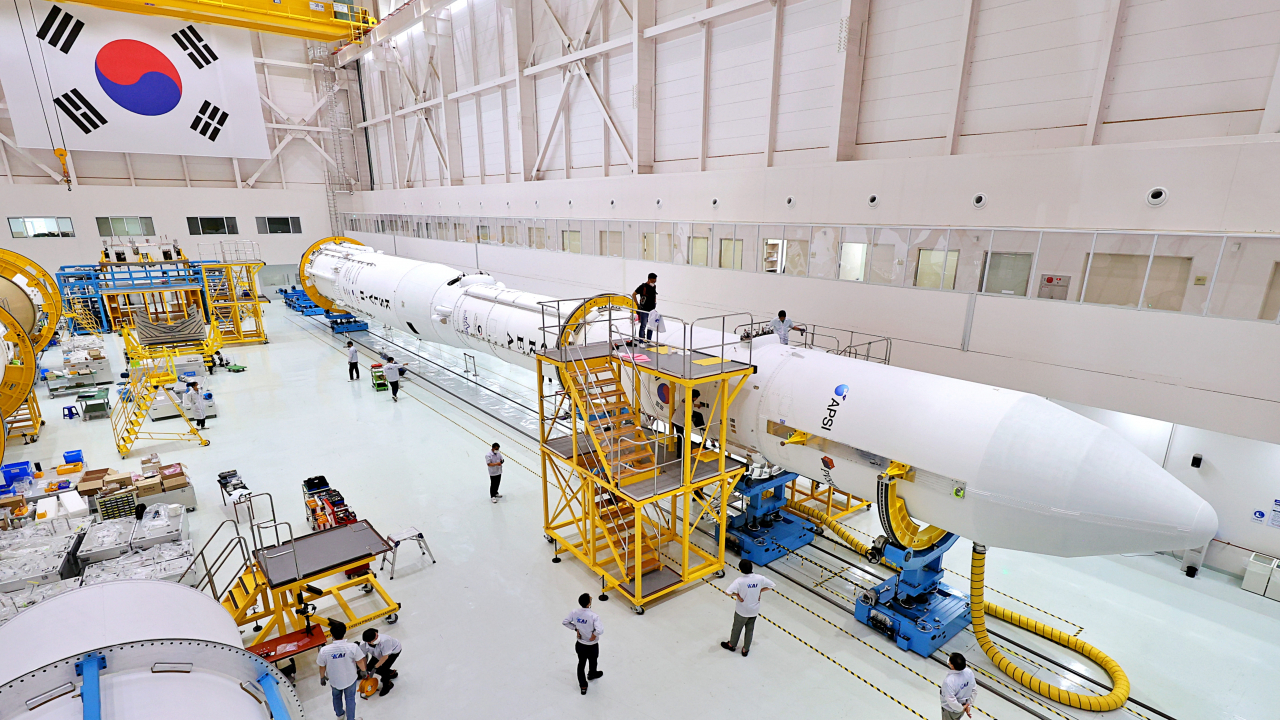Market Now
[KH Explains] Korea’s next-generation space rocket project off to bumpy start
 |
Researchers and engineers link the Nuri space launch vehicle’s first- and second-stage rockets with its third-stage rocket at the Naro Space Center in Goheung, South Jeolla Province on June 8, 2022. (Korea Aerospace Research Institute) |
Korea’s 2 trillion won ($1.5 billion) next-generation space launch vehicle project got off to a bumpy start, as the bidding process to select a private entity to lead the large-scale task is likely to be a one-man show.
Officially named the Korea Space Launch Vehicle-III, the goal of the next-generation rocket project is to assemble a launch vehicle capable of sending a lunar lander to the moon in 2032. The improved rocket will have a mission capacity some three times stronger than the homegrown Nuri rocket, which proved Korea’s ability to successfully place a satellite weighing 1 metric ton or higher into orbit with a self-developed launch vehicle through a couple of successful launches in May 2023 and June 2022.
At first, the bidding race was expected to be between Hanwha Aerospace and Korea Aerospace Industries, with Korean Air sizing up the competition as all three companies took part in the state-run Korea Aerospace Research Institute’s project presentation last year.
Korean Air said it will not take part in the bidding on Feb. 15. This was no surprise because the country's flag carrier had already been working with KARI for the Korean Positioning System, a regional satellite navigation system for the Korean Peninsula.
The government’s previous large-scale bidding to select a company to lead the project of upgrading the homegrown Nuri rocket and launching it four more times through 2027 was a close call between Hanwha Aerospace and KAI, before Hanwha eventually won the bid in December 2022.
The bidding for the KSLV-III was projected to be another showdown between Hanwha and KAI. However, the tension diffused when KAI unexpectedly announced its decision not to take part in the bidding on Feb. 21, the deadline for the bidding application.
KAI shifts focus
Announcing the decision to forgo the bidding, KAI said in a statement that it made a choice to draft an independent space mobility business strategy based on its “Global 2050 Vision” and concentrate its capabilities to enter the global space market.
“We will push for developing space mobility such as reusable launch vehicles with a high commercial value, air launch vehicles based on multipurpose cargo aircraft and spacecraft that are required by the market in the new space era,” KAI said.
“Based on this, we will bring forward the realization of the space economy through popularizing and commercializing the use of space.”
In January last year, KAI unveiled its plan to invest 4.5 trillion won in research and development through 2032 to achieve an annual revenue of 40 trillion won in 2050 and become one of the top seven aerospace firms in the world.
KAI clarified that it would join the country’s next-generation launch vehicle as a participant -- not the leading entity -- and put its best effort into a successful project, acknowledging the importance of the space task for Korea and its decade-long experience in assembling the first-stage propellant tank, a key component of every Korean space launch vehicle project since 2014.
Hiccups from get-go
When the Public Procurement Service first announced the bidding process in November last year, the Ministry of Science and ICT laid out the timeline of selecting a preferred bidder by the end of February and confirming which company will lead the KSLV-III in March.
With KAI dropping out of the bidding, the government had to repost the bidding notice on Feb. 22 with the bidding period set between March 4 and 6. If Hanwha Aerospace ends up being the sole bidder once again, the selection will be done in the form of a sole-source contract, according to the government. Hanwha has made it clear that it is committed to participating in the re-bidding.
The Ministry of Science and ICT and KARI explained that the delayed bidding will not impact the timetable of the overall project.
However, space industry officials and experts expressed concerns over the tepid interest from the private sector and possible pushbacks in the development of the next-generation rocket.
"Unlike the Nuri rocket project that selected a private company to lead further advancement of the launch vehicle after the state took charge at the beginning, the next-generation launch vehicle project was the government’s first project that had been planned as a procurement project from the beginning," said an aerospace professor who wished not to be named.
"(The government) probably hoped for more interest and maybe more competition from the private firms."
An anonymous official at a space firm pointed out that the final confirmation of the bidding process could be postponed to April.
"Once Hanwha becomes the sole-source contract negotiator, the maximum period of the negotiation can be extended up to 25 days," said the official.
"(The government) hopes to sign the contract before the end of March, but it might be done in April and push back the entire timetable of landing on the moon in 2032."
By Kan Hyeong-woo (hwkan@heraldcorp.com)


![[India Forum] Creating synergy with local development know-how](http://res.heraldm.com/phpwas/restmb_idxmake.php?idx=151&simg=/content/image/2024/11/26/20241126050072_0.jpg)
![[India Forum] Kintex hopes to become growth platform in India](http://res.heraldm.com/phpwas/restmb_idxmake.php?idx=151&simg=/content/image/2024/11/26/20241126050070_0.jpg)
![[India Forum] India's Haryana, Korean delegation look to bolster ties](http://res.heraldm.com/phpwas/restmb_idxmake.php?idx=151&simg=/content/image/2024/11/26/20241126050064_0.jpg)
![[India Forum] Tapping into young, growing population](http://res.heraldm.com/phpwas/restmb_idxmake.php?idx=151&simg=/content/image/2024/11/26/20241126050063_0.jpg)
![[India Forum] Indian automobile market is 'sunshine industry'](http://res.heraldm.com/phpwas/restmb_idxmake.php?idx=151&simg=/content/image/2024/11/26/20241126050061_0.jpg)
![[India Forum] India, more than a manufacturing hub](http://res.heraldm.com/phpwas/restmb_idxmake.php?idx=151&simg=/content/image/2024/11/26/20241126050060_0.jpg)
